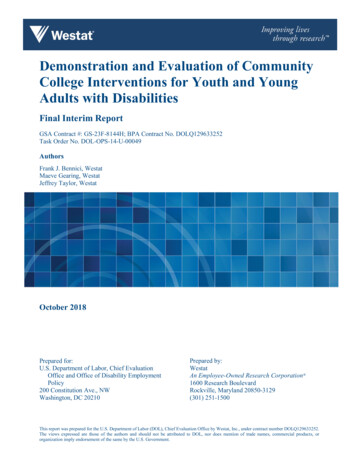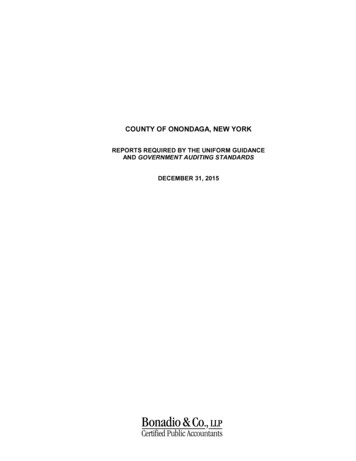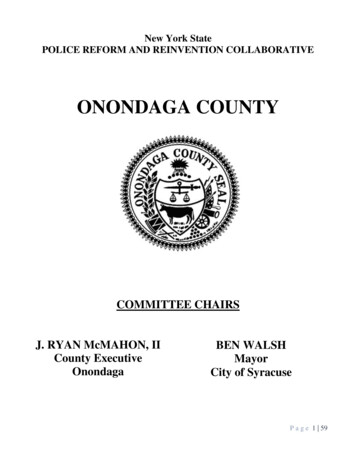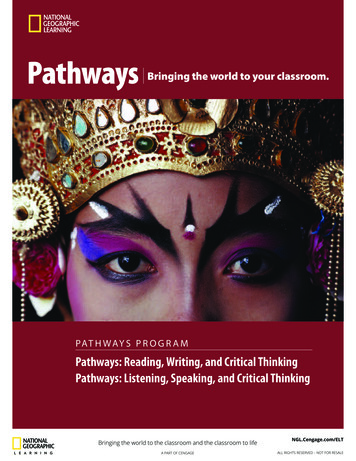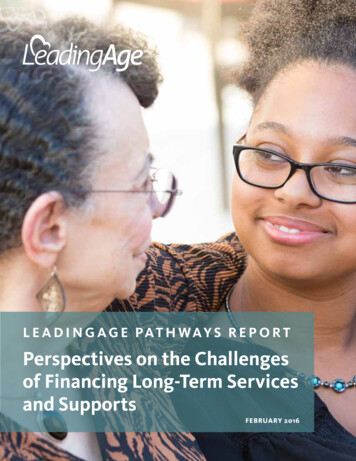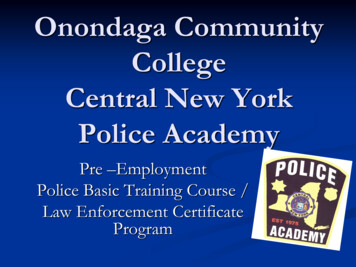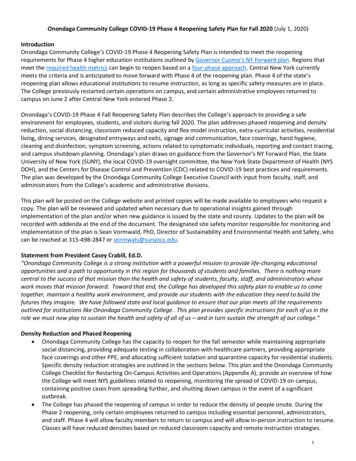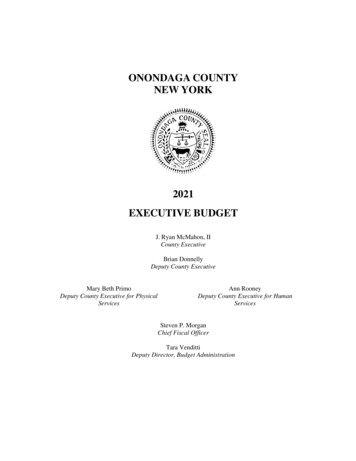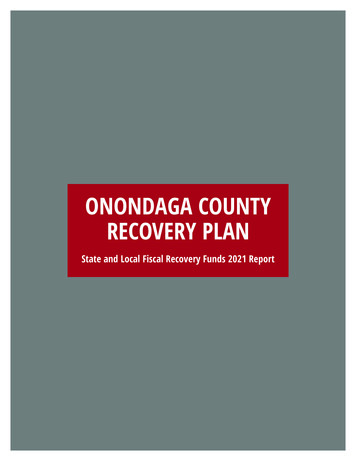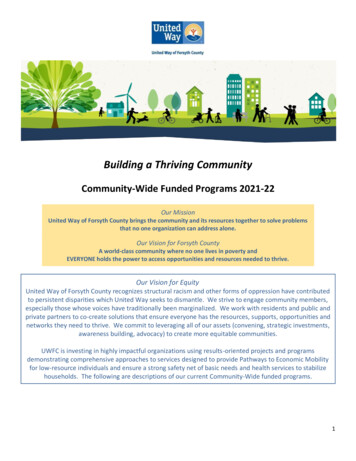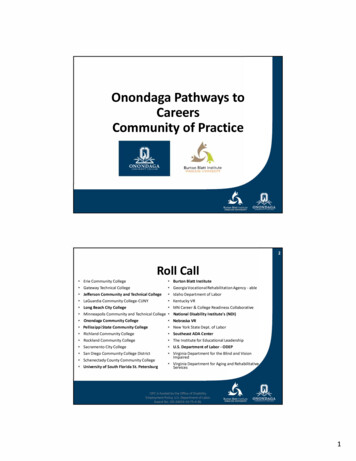
Transcription
Onondaga Pathways toCareersCommunity of Practice/'A ONONDAGA{ OMM\!NITY { 011 HfErie Community CollegeGateway Technical College Burton Blatt InstituteSYRACUSE UNIVERSITYRoll CallBurton Blatt InstituteGeorgia Vocational Rehabilitation Agency - ableJefferson Community and Technical CollegeLaGuardia Community College-CUNYIdaho Department of LaborOnondaga Community CollegeNebraska VRNew York State Dept. of LaborKentucky VRMN Career & College Readiness CollaborativeLong Beach City CollegeMinneapolis Community and Technical College National Disability lnstitute's (NDI)Pellissippi State Community CollegeRichland Community CollegeRockland Community CollegeSoutheast ADA CenterT he Institute for Educational LeadershipSacramento City CollegeU.S. Department of Labor - ODEPSan Diego Community College DistrictVirginia Department for the Blind and VisionImpairedSchenectady County Community CollegeUniversity of South Florida St. PetersburgVirginia Department for Aging and RehabilitativeServices1
Agenda Welcome! Presentations from Jordan Knab, Barry Whaley,Rebecca Salon: Blending and Braiding Funding Possible funder & partner: American Job Centers Introduction: Maria Ek Ewell, Long Beach City College Next Meeting: Universal Design in Learning; RichlandCommunity CollegeJordan T Knab, Ed.S.Principal Investigator, K-16 Education InitiativesFlorida Consortium on Inclusive Higher EducationProject 10: Transition Education NetworkSEDNET Statewide Administration ProjectFlorida Check and ConnectPresident, FL APSEUniversity of South Florida St. PetersburgCollege of Education2
Post-SecondaryInclusion in KentuckyBarry Whaley, M.S.Postsecondary Inclusion in Kentucky TimelineDEPPBCTC CTPPIP funded2008Murray CTPSHEP funded20092010Spalding CTPFunding endsNK CTPKY HB 452011201220132014201520163
Supported Higher Education in Kentucky2008-2015students serve d,. . ,. , .,,l'8supported HieherEducauon in Kentucky10Students earolled in college courses2008 2015 - Studentscompletiogcollelec,.denti I g r . g ' - lnslilulional Impact ---- w " ki:::.8ClCClP-O(PP ldlncCTP - ,.,' Murr CTPPIPfu IC't'H8 5llt,,g:einnructor hiidtheopporwnitytoC.· · H.P "m "'" ohipswerefacilitate dbetween. studentsw,thlDandstudentsw,thout. . .d1ub1lit1l'SiNKU:: ncI51- a51 51.:ee,ndsComprehensiveTn,n itionImproved quality o(ffe meo5ure,s. A recentstudy of National Core Indicators data foundthat in addition to being less likely to hove aguardian, those individuals who completed atfeast two semesters of ca/fege had osignificantly improved quality of life acrossHigher Education Opportunity Act(PL 110-315)Higher Education Act of 1965(HEA) provided financial aidfor low income students.Amendments to the HEA in2008 improved access forstudents with intellectualdisabilities to postsecondaryeducation.4
Higher Education Programs for Studentswith Intellectual Disability in the U.S.2004 to 2018See 4Higher Education Opportunity Act(slide 1of2) Student must meet the definition of intellectual disability. Student must be attending an approved ComprehensiveTransition Program. Student who meets the financial need criteria are eligible forFederal Financial Aid.5
Higher Education Opportunity Act(slide2of2) Students may have, but do not need to have, a standard highschool diploma. Student is not eligible for student loans. Student is eligible for work study.Kentucky Higher EducationExcellence Funds Originally HB 45 allowed for 250 per semester forstudents taking 6 or more credit hours and 125 persemester for students taking 6 or fewer hours In 2016 HB 158 amended HB 45 and students nowreceive 500 per semester for 6 and 250 per semesterfor 6 hours Students are not required to have a standard diploma Students must be enrolled in a Comprehensive TransitionProgram6
Three Principals of InclusiveHigher EducationExplorationEmployment for people age 18-26 with ID lag behind youth withoutdisabilities and youth with other disabilitiesYouth with ID who attend highereducation are 25% more likely toYouth with ID who participate inexit with a paid Job than if they only both higher education and VR have75% higher incomeused VR as their post-secondaryexperienceSoun -: Butlerworth, et.al., American Community Survey (2010)7
Vocational Rehabilitation ServiceFee Memorandum Does theinternshiplead to a joboutcome? Do classesreflectstudentinterest? 3 internshipopportunitiesduring thecourse ofstudy 1,500 perstudent persemester/ 3,000 perstudent peracademicyearKentucky Works A sub-committee of Kentucky Works Funded by US Administration on Intellectual andDevelopmental Disabilities, Administration forCommunity Living. Partners include University of Kentucky Human Development Institute Kentucky Division of Intellectual and DevelopmentalDisabilities Kentucky Protection & Advocacy Office for the Blind Commonwealth Council on Developmental Disabilities Office on Autism Kentucky Autism Training Center at University of Louisville8
Kentucky Post-Secondary InclusionWorkgroupThe workgroup is funded by Think College! At Universityof Massachusetts Boston Promoting greater knowledge of students, families, K-12education systems, and institutions of higher educationabout quality higher education programs as a tool toimprove outcomes for students with ID. Increasing participation of students with ID in competitiveintegrated employment, valued community membershipand independent living, and Aligning policy and guidance across entities involved in highschool transition.Workgroup objectives Objective 1 - Establish a state-level postsecondary work team Currently, KentuckyWorks convenes three work teams around 1) policy,2) family/advocacy, and 3) marketing. The postsecondary work team willbecome the fourth active work team. Objective 2 - Conduct Postsecondary Community Conversation Community Conversations have shown to be a powerful mechanism inKentucky planning around employment. Community Conversationspromote broad representation of voices with a shared interest. Objective 3 - Develop and maintain online resources aroundpostsecondary options for students with ID - the existing KentuckyWorkswebsite targets audiences that include youth with disabilities, families,educators, rehabilitation professionals, and employers.9
Workgroup Members Commonwealth Council on Developmental DisabilitiesJefferson County Public SchoolsUniversity of Kentucky Human Development InstituteDepartment of Aging and Independent LivingKentucky Community Technical College SystemEducational CooperativeUniversity of Kentucky DSOWestern Kentucky University StudentDepartment of Vocational RehabilitationOffice for the BlindJefferson County Community Technical CollegeCouncil on Post-Secondary EducationKentucky Department of EducationStill Have Questions?Contact the Southeast ADA CenterTelephone800-949-4232 (toll free)404-541-9001711 theast.org10
TPSID and Think College in NV http://www2.cuny.edu/current-students/student ve/ http://www.nytransition.org/what-we-do/tcny/ ebecca SalonRebecca Salon is Project Director for the LEAD Center. Dr. Salon is a recognized national leader inpolicy and program development with an emphasis on cutting edge demonstrations that promoteemployment and economic self- sufficiency for individuals with significant disabilities. She has morethan twenty years of experience with management of federally funded projects and has over thirty five years of experience working with people across the spectrum of disabilities. Her doctorate degreeis in special education with studies and research geared toward disability policy studies. Salon also isworking at the District of Columbia Department on Disability Services (DDS), where she is the lead forDC's Employment First program initiatives.Over the past 6 years, Salon has worked in DC government focusing on program, policy andpartnership development to promote Employment First systems cnange, in addition to otherinitiatives through DDS's developmental disabilities and vocational rehabilitation administrations. Thiswork has included creating and supporting Communities of Practice to promote and implementCustomized Employment; coordinating Project SEARCH partnerships and programs within the Federalgovernment; overseeing and coordinating the activities of DDS's Medicaid Infrastructure Grant (MIG);fostering a collaboration between the workforce and vocational rehabilitation system on universaldesign practices in their respective roles; and working on multiple partnerships designed to promoteemployment for youth and young adults with disabilities. Almost all of her energies have beenfocused on creating opportunities for employment, community inclusion, and economic self sufficiency for youth and adults in the District of Columbia. She is actively engaged with the StateEmployment Leadersh· Network's work in DC and was instrumental in creating an AdministrativeEmployment Network EN) at DDS to expand the job retention support that can be available to peoplewith disabilities throug the Ticket to Work program.Salon previously was Executive Director of the Lt. Joseph P. Kennedy Institute, where she worked for20 years in positions that spanned all of its pro rams and projects. Since 1988, Salon has been anadvisor to Project ACTION!, a DC-based state-wide self-advocacy coalition run by adults withdevelopmental disabilities, and has worked with a number of family advocacy coalitions in DC andMaryland. Her Master's and Doctorate are from Syracuse University. She also previously worketheir Center on Human Policy and in a number of other non-profit management positions.11
Braiding and Leveraging ResourcesFebruary 22, 2018Onondaga Pathways to CareersCommunity of PracticeLEAD CENTER[ g;{,1; a n e; /yet JJa 3 ff a/f!J-J. ility Institute and is funded by the Office of Disability Employment Policy, U.S. Department ofCurrent Federal Approach Multiple agencies administering multiple fundingstreams at the Federal, state and local levels Each system created in response to varying publicpolicy priorities, governed by separate Federalstatutes and regulations No single source of funds or resources is able torespond effectively to individuals with disabilitieswho often face multiple barriers to employment12
LEAD Center 2013 Public Policy RoundtableMAKING COLLABORATION REAL: Building aProgressive Vision for a Policy and Service DeliveryFramework that Promotes the Effective Leveragingof Resources to Improve Employment &Socioeconomic Advancement of Youth and Adultswith DisabilitiesLEAD Center 2013 Public PolicyRoundtable Materialswww.leadcenter.orI I I Ire ort-briefI I I I Definition of Terms Resources for Blending and/or Braiding Representative Examples of Strategies for LeveragingResources across Service Delivery Systems to PromoteEffective Practices that Lead to Integrated Employment &Socioeconomic Advancement of Individuals with Disabilities Decision Point Options for Blending and/or BraidingResources and Cross System Collaooration Common Elements in Successful Case Examples Building a Roadmap at an Individual and Systems Level Background Paper (Making Collaboration Real) LEAD Center 2013 Public Policy Roundtable re o13
Related definitions Blended funding occurs when dollars from multiplefunding streams are combined to create a single"pot" of dollars that is then used to purchase oneor more specific services that support an individualwith a disability in pursuing, obtaining ormaintaining integrated employment. Braided funding occurs when multiple fundingstreams separately and simultaneously, purchaseand provide specific services that support anindividual with a disability in pursuing, obtaining omaintaining integrated employment.Other relevant definition Sequenced funding occurs when multiple fundingstreams separately and sequentially purchase andprovide specific services that support an individualwith a disability in pursuing, obtaining ormaintaining integrated employment. Very little blending going on in practice Most braiding is really sequencing14
Current experience Most of what is contained in Federal statutes,regulations and guidance is still often interpreted asprohibiting (or sharply restricting) blending andbraiding Identifying individual programs as "payer of lastresort" is inconsistent with cost sharing approachthat is neededResource Mapping Resource mapping offers a strategy that can helpleverage a community and organization's capacityto serve individuals. Helps agencies identify areas of strength, as well aswhere they need additional support.15
Resource MappingImportance of Resource Mapping Enhances cross collaboration between agenciesworking towards the same goal of economic self sufficiency. Enhances referrals to other organizations that canassist an individual in achieving their goals. Creates an opportunity for soft referrals vs. hardreferralsResource MappingImportance of Resource Mapping: Important strategy in integrated services. Provides an opportunity for the blending andbraiding of resources amongst a variety oforganizations. Assists in identifying the gaps within thecommunity to assist individuals build their financialwell-being.16
Integrated resource teams IRTs are for job seekers with: Identified multiple barriers to employment An increased need for services, supports and/or resources IRTs increase braiding & leveraging resources by: Enhancing cross program collaboration and service alignment Developing an integrated career plan The outcome: This service delivery strategy aligns workforce partners around anemployment goal for an individual job seeker, which allows eachprovider to maintain their service plans while braiding andleveraging resources, funding and services. The IRT approach can be implemented immediately, with nomodification to provider service models.The ABLE ACT & EMPLOYMENT Resource on The ABLE Act and Employment:Strategies for Maximizing the Effectiveness of theAchieving a Better Life Experience (ABLE) Act as aTool for Financial Stability and EmploymentOutcomes of People with Disabilities17
ABLE ACT creates Newopportunities for collaboration American Job Centers Workforce DevelopmentProfessional VR agency Counselors Community Work Incentive Coordinators Medicaid Support Coordinators State ABLE Program Managers Financial Institution Customer Representatives Disability Employment Service Providers Alternative Financing ProgramsTeachable moments related toABLE accounts Individual Education PlansIndividual Transition PlansIndividual Plans for EmploymentIndividual Service/Support PlansIndividual Benefits PlansIndividual Financial PlansIndividual Tax Returns and Refunds18
Connect with the LEAD Center Website: www.leadcenter.org D R I V E : Data & Resources to Inspire a Vision for Employmenthttp://drivedisabilityemployment.org/ Sign up for LEAD Center News: http://eepu rl.com/sQi H r Follow the LEAD Center on . Facebook: www.facebook.com/LEADCtrTwitter: @LEADCtrLinkedln: linkedin.com/groups/LEAD-Center-4828089YouTube: https://www.youtube.com/user/LEADCtr Contact us: Rebecca Salon, Project Director, rsalon@ndi-inc.org Elizabeth Jennings, Asst. Project Director, ejennings@ndi-inc.org Aramide Awosika, Project Coordinator, aawosika@ndi-inc.orgPossible Funder & Partner:American Job Centers CNY Works Youth Services is committed to preparing our 1624 year old participants for careers, not just entry-level jobs. Through a variety of enrichment activities, our educationaland vocational opportunities enable youth and young adultsto make better educational and occupational decisions. We seek to place as many youth as possible in appropriate,meaningful jobs in safe settings, while providing exceptionalsupports, academic enrichment and opportunities to gainmarketable skills; and to provide the community andbusinesses a view of our local emerging workforce at itsbest.19
Apprenticeship Accelerator Career Training A unique opportunity to get paid while you're trained for an Apprenticeship inAdvanced Manufacturing jobs. Qualified applicants will be selected for a ten-weekintensive training program delivered at OCC. No Experience Needed - AACT will pay you while you get trained, on your way to aguaranteed 4-year apprenticeship in advanced manufacturing with benefits and built in pay increases. Sign up today to be on your way to a 10-week paid training program. A Career Path - Employers need you for career-path jobs in advanced manufacturing.Train for positions including CNC Machinist, Machinist, Tool Maker, and MaintenanceMechanic and continue your training and education through your employment toachieve journey worker status through a New York State registered apprenticeship. Learn, Grow, Thrive - Orientation begins with a required information session onFebruary 20 and you must be present to be considered for the program. Trainingbegins in March and runs through May. Starting pay post-training is 13/hr andincludes built-in, merit-based pay increases over the 4-year apprenticeship period. Apprenticeship Accelerator Career Training (AACT) is a program of OnondagaCommunity College and a unique collaboration coordinated by OCC's Office ofEconomic & Workforce Development. Training is provided by OCC with additionalapprenticeship, project and employer support provided by American ApprenticInitiative, Manufacturers Association of Central New York, and Jobs for the FMember Introduction ! Maria Ek Ewell, Long Beach City College Specialized counseling services Academic, career and disability management counseling services with staff whounderstand the educational limitations presented by a disability. Learning disabilities assessment Registration assistance Financial Aid liaison Referrals to resources on and off campus A wealth of campus and community resources are available to support studentsin their pursuit of their educational, vocational and personal goals. Assistive computer technology Services for deaf and hard of hearing students20
ResourcesNew Members & Resources AreWelcome ! P l ease send M ee ra ( ma dya @syr.ed u )reco m m e n dations fo r a d d itio n a l m e m be rs,especia l ly stu d e nts a n d e m p l oye rs. P l ease co n n ect us to a ny peo p l e we s h o u l dbe i n c l u d ing i n t h e p roject. P l ease se n d us (or po i nt M ee ra i n t h ed i rection of) a ny resou rces yo u h ave o rknow a bo ut t h at yo u th i n k w e s h o u l d u s e .21
Next Meeting: Date & Topic O u r meeting sched u le wi l l be eve ry m o nth,t h e last Th u rsday of t h e m o nth, fro m 1 2 : 001 : 30 EST. So, our next meeting is March 29 th, 2017, Noon EST U n ive rsa l Design i n Lea rn i ng Rich l a n d Co m m u n ity Co l lege22
Community of Practice /' A ONONDAGA { OMM\!NITY { 011 Hf Burton Blatt Institute SYRACUSE UNIVERSITY Roll Call Erie Community College Gateway Technical College Jefferson Community and Technical College . LaGuardia Community College-CUNY . Long Beach City College . Minneapolis Community and Technical College Onondaga Community College .
